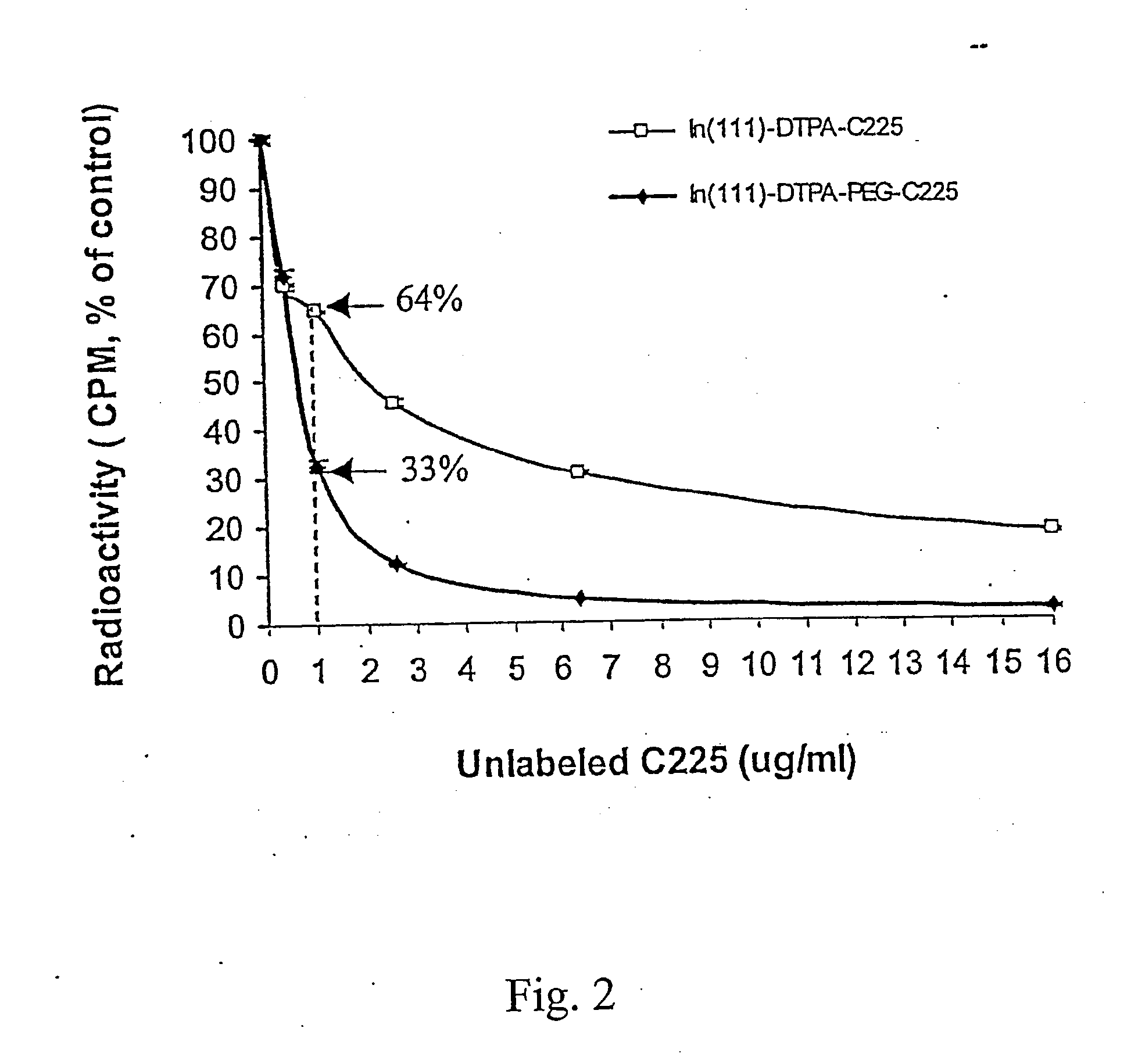Diagnostic Imaging Compositions, Their Methods Of Synthesis And Use
a technology of diagnostic imaging and composition, applied in the field of compositions, can solve the problems of significant liver uptake and rapid clearance from the body after administration, and achieve the effects of reducing liver uptake, reducing liver uptake, and improving imaging ratio
- Summary
- Abstract
- Description
- Claims
- Application Information
AI Technical Summary
Benefits of technology
Problems solved by technology
Method used
Image
Examples
example 1
Materials
[0124] The following materials were used in Examples 1-16. Antibody C225 was kindly provided by ImClone Systems Inc. (New York, N.Y.). t-Boc-NH-PEG-NH2 (MW 3,400) was obtained from Shearwater Polymers, Inc. (Huntsville, Ala.). N-succinimidyl s-acetylthioacetate (SATA), N-γ-maleimidobutyryloxysuccinimide ester (GMBS), 2,4,6-trinitrobenzenesulfonic acid (TNBS, 5% w / v aqueous solution), 5,5′-dithio-bis(2-nitrobenzoic acid) (Ellman's Reagent), sodium dodecyl sulfate (SDS), (3-(4,5-dimethylthiazol-2-yl)-2,5-diphenyltetrazolium bromide (MTT), and PBS (0.01 M phosphate buffered saline containing 138 nM NaCl, 2.7 nM KCl, pH 7.4) were purchased from Sigma Chemicals (St. Louis, Mo.). DTPA-dianhydride, trifluoroacetic acid (TFA, anhydrous), ninhydrin, triethylamine (TEA) and all the other solvents and reagents were purchased from Aldrich Chemicals Co. (St. Louis, Mo.). All chemicals and solvents were at least ACS grade and were used without further purification. 111Indium radionuclid...
example 2
Preparation of DTPA-C225
[0125] DTPA-C225 was prepared using a previously described method (Science 220: 613-615, 1983). Briefly, DTPA-dianhydride (4.6 mg, 12.8 μmol) was added to an aqueous solution of C225 (2.4 mg, 0.016 μmol; 2.4 mg / ml). For reaction efficiency, the pH of the reaction solution was kept at 7-8 by adding 0.1 M Na2HPO4. After incubation at room temperature for 1 hour, the solution was concentrated to half volume on a Centricon-YM 10 centrifugal filter and purified from free DTPA by gel filtration on a PD-10 column.
example 3
Preparation of DTPA-PEG-NH2
[0126] To a stirred suspension of DTPA-dianhydride (143 mg, 0.4 mmoles) in 4 ml chloroform was added TEA (81 mg, 0.8 mmoles) and t-Boc-NH-PEG-NH2 (340 mg, 0.1 mmol). The mixture was allowed to react at room temperature for 2 hours. The reaction was followed by silica gel TLC using CHCl3—MeOH (4:1 v / v) as the mobile phase; the plates were visualized by both iodine vapor and ninhydrin spray (0.1% ninhydrin solution in ethanol). TLC showed complete conversion of NH2-PEG-NH-t-Boc (Rf=0.55, purple in ninhydrin) to DTPA-PEG-NH-t-Boc (Rf=0.4 with iodine vapor, negative in ninhydrin). After the reaction, the chloroform and TEA were removed under vacuum. The t-Boc protecting group was removed without purification by adding TFA (2 ml) to the resulting residue and stirring the mixture at room temperature for 4 hours. The resulting DTPA-PEG-NH2 was purified by dialysis against PBS and deionized water using dialysis tubing (MWCO, 2 KD). Rf, 0.18 (chloroform-methanol; ...
PUM
 Login to View More
Login to View More Abstract
Description
Claims
Application Information
 Login to View More
Login to View More - R&D
- Intellectual Property
- Life Sciences
- Materials
- Tech Scout
- Unparalleled Data Quality
- Higher Quality Content
- 60% Fewer Hallucinations
Browse by: Latest US Patents, China's latest patents, Technical Efficacy Thesaurus, Application Domain, Technology Topic, Popular Technical Reports.
© 2025 PatSnap. All rights reserved.Legal|Privacy policy|Modern Slavery Act Transparency Statement|Sitemap|About US| Contact US: help@patsnap.com



